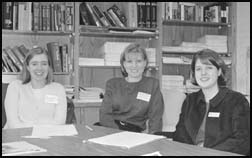 The hospital will be doubling as a school for the next ten weeks.
The hospital will be doubling as a school for the next ten weeks. Paynesville Area Health Care System is one of seven outstate facilities hosting a Rural Health School over the next two months. Funded by the Minnesota Legislature, the schools are intended to foster interest in rural medical practice, promote interdisciplinary teamwork, and provide research to the host community.
Taking part in the school here are Erin Osborn and Ruth Klatt. Their site coordinator is Laura Odell, a doctor of pharmacy (pharmD) at Paynesville Area Health Care System. Shara Mihm, a year-long pharmD resident for the hospital system, will be assisting Odell with teaching the Rural Health School.
Osborne arrived in November and is spending nine months in Paynesville as part of the Rural Physician Associate Program through the University of Minnesota. She is improving her clinical skills by working with Dr. Youngs and Dr. Zimmerman. After another year of medical school at the University of Minnesota-Twin Cities campus, she will graduate in May 2000.
Klatt arrived in Paynesville last week. She is a doctor of pharmacy student at the University of Minnesota-Twin Cities. During the ten-week Rural Health School, she will work with Odell in reviewing medications for hospital and Koronis Manor patients, in seeing patients at the clinic, in providing education to hospital patients, and in doing pain assessments at Koronis Manor.
For her last year of school, Klatt started with medical rotations last June. She has already completed rotations at Children's Hospital, St. Paul, at the Veteran's Administration Medical Clinic, at North Memorial Hospital, and for the diabetes clinic at Hennepin County Medical Center. She will graduate in June 1999.
The Rural Health School started with a retreat on the weekend of Feb. 27 and 28. Other health care system personnel attending the meeting were nurse practitioner Shari Heitke, Dr. Allan Solum, Dr. Julie Youngs, and Pat Solum, head of the laboratory.
"One of the major goals is to get students from all different health schools to work together in an interdisciplinary team," said Klatt. Osborne and Klatt represent physicians and pharmacy, but the school could include students of nurse practitioning, nursing, physician's assistants, social work, and even mortuary science.
In addition to their clinical work with their respective staff members, Osborne and Klatt will be completing a curriculum designed by Odell every Tuesday. The first day, Tuesday, March 3, was mainly an introduction to the community. They spent yesterday in Willmar, and will be touring the Gold'n Plump facility in Cold Spring next week to learn about occupational health.
Other topics won't require them to leave the hospital facility, including an overview of the home health visits, hosting the Rural Health School group from Willmar, and doing case studies with various health care system personnel.
A major part of the program will be the group project. The students need to assess the community's health needs and develop a plan to address a problem. After carrying out their plan, they will need to assess its impact. They haven't decided on a project yet.
In Willmar last year a Rural Health School project dealt with providing preventative health care to Hispanic women. Because of high teen pregnancy rates, the project in Itasca County dealt with educating teens about preventing pregnancies.
Last summer, the hospital hosted the National Health Service Corps summer experience, a similar program that is federally funded. The four students then, including a future doctor, nursing practitioner, a pharmD, and a physician's assistant, did a project on skin cancer awareness.
Paynesville is one of seven Rural Health Schools this year. The others are located in Hibbing, Itasca County, Moose Lake, New Ulm, Staples, and Willmar.